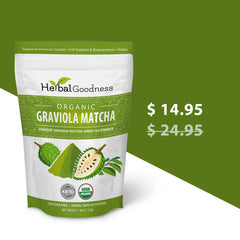What’s the Deal with Graviola? | Herbal Goodness
You may have noticed a new product on the Herbal Goodness' site, Graviola! So, what exactly is it?
What do you get when you mix ravioli with granola? Graviola!! Kidding, but I had to start off with at least one bad joke to get you hooked. There’s no doubt that Graviola, or its alternative name, soursop, is a mouthful. It doesn’t roll off the tongue as nicely as some other fruits, like papaya.
You shouldn’t be so quick to discount this fruit because of its interesting name; however, Graviola is the new kid on the block (at least in the Western World) and it has a lot of health benefits that are still constantly being discovered in studies today.
So, what’s the deal with Graviola?
I’m armed with some common questions about the fruit to give you a better idea of what Graviola really has to offer.
Related: When The Bacteria in Your Body is Off Balance
Where does Graviola come from?
The plant is native from the Amazon jungle and the Caribbean Islands. Graviola tree leaves have been traditionally used for their various therapeutic properties throughout the years in the communities where it is native.
Graviola is the fruit of Annona muricata, a flowering evergreen tree that is best grown in areas of high humidity and relatively mild winters. Graviola goes by a lot of names around the world, including soursop, custard apple, guanabana, and Brazilian paw-paw.
What does it look like?
Graviola has been described as a cross between a green Granny Smith apple and a pineapple…on steroids.
The heart-shaped fruit generally grows to about 8-12 inches in size, is long, prickly, and green, and can weigh up to 15 Ib. The inside of the fruit consists of soft white pulp, fiber, and black seeds. The pulp is what’s often used to make fruit nectar, smoothies, juice, as well as some candies and ice cream flavors.
What does it taste like?
Graviola has been described as tasting similar to a combination of strawberry and pineapple, with sour citrus notes and an underlying creamy flavor reminiscent of coconut or banana.
What are Graviola’s health benefits?

In recent scientific studies, annonaceous acetogenins, the active constituents of Graviola, have been suggested as beneficial to supporting healthy cell growth and function.
Graviola has also been used for its calming effects and as a supplement to help maintain a positive mood. In the Caribbean, people often even use it as a sleep aid by brewing the leaves into a tea to get a good night’s rest and feel rejuvenated in the morning.
The fruit has a variety of nutrients that help boost the immune system, making it a healthy addition to anyone’s diet. Some of these nutrients are known to help eliminate free radicals and make sure your body is functioning at optimal levels.
Why have we introduced Graviola as a new Herbal Goodness product?
At the Herbal Goodness headquarters, we’re always on the lookout for quality unique products that provide health benefits, benefits that offer a natural organic remedy to common health issues or a boost in an overall healthy lifestyle.
With a recent trip to her home country of Nigeria, where Graviola is a common fruit readily used in herbal medicine, our CEO & founder Unoma decided to bring back some of the knowledge and perspectives she learned in Africa to introduce a new product to Herbal Goodness.
Although our true love will always be papaya, we’re also a company that’s open to exploring additional avenues of alternative medicine and health from around the world. Our goal is to produce the highest quality products that are a great addition to any healthy lifestyle and mindset.
To us, Graviola is an exciting product that still has a lot of undiscovered health benefits in the Western World. We hope you feel the same way too and we look forward to introducing you more to the funky-looking fruit with the interesting name.
Would you try Graviola? Check out our BRAND NEW Graviola products here to learn more and figure out if it’s right for you!
Related: Graviola Green Tea Smoothie | Herbal Goodness










